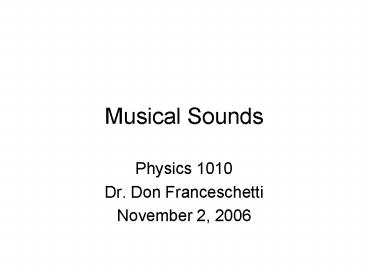Musical Sounds PowerPoint PPT Presentation
1 / 19
Title: Musical Sounds
1
Musical Sounds
- Physics 1010
- Dr. Don Franceschetti
- November 2, 2006
2
Musical sound is different from noise
3
Attributes of Musical Sound
- Pitch Frequency
- Loudness Intensity
- Quality - Timbre
4
Pitch
- Strange as it seems, our musical scale is based
on the twelfth root of 2 1.059463... - E/C is almost 5/4
- G/C is almost 3/2
- Some modern scales use finer divisions
5
Remember
- Pythagoreans got music going by noting that
strings with lengths in the ratio small whole
numbers sounded nice together. - Kepler (1571-1630) Harmonies of the World related
planetary distances to musical tones - Today, string theory
6
Standing waves on a string
7
More generally
8
Pitch
- Wind instruments (brass or wood) determined by
length of air column. - Stringed instruments determined by length and
tension of string. - Percussion determined by plate or drumhead
vibration. - Most music below 4000 hertz.
9
Intensity
- Ear is very sensitive but can hear over wide
range - Threshold of hearing 10-12 W/m2, defined as 0 bel
- 10 times intensity is 1 bel or 10 decibels
- 2 bels is 10 times intensity for 1 bel,
- And so on up through 120 decibels, the threshold
of pain - 140 decibels or 100 W/m2, jet engine
- Webers Law The change in stimulus intensity
that can just be discriminated is a constant
fraction of the starting intensity of the stimulus
10
Loudness
- Is the physiological sensation corresponding to
pitch - The study of the relation between stimuli and
perception is called psychophysics - Roughly, most of our sense organs are logarithmic
(Webers law)
11
Quality
- Is determined by the mixture of harmonics
- Fundamental frequency harmonics (overtones)
- Fourier analysistakes composite waves and breaks
them up into frequencies
12
Quality
13
Ernst Chladni (1756-1827)
- Amateur musician and inventor of musical
instruments. - Chladni figures, formed by sand on vibrating
plates. Key to understanding soundboards and
percussion. - Demonstrated before French Academy of Sciences in
1808, with Napoleon present. Napoleon offers
prize to scientist who could explain what
happened. - Problem solved by Sophie Germain in 1816
- Sand collected on nodes.
- May have inspired Edison to invent phonograph.
14
Ernst Chladni
15
Chladni figures
16
Drum heads
- Different modes have different nodes
- Radial nodes
- Angular nodes
- Electron motions in atoms and nucleon motions in
nuclei have modes of vibrating ball - Sun and moon are ringing like a bell
- Was Kepler right?
17
Recording Sound
- Phonograph record, sound recorded in analog form.
- How many groves on a record?
- CD waveform coded as numbers. Sampling 44,100
times a second. Suppresses noise.
18
Digital Recording 44,100 times a second
19
Digital Playback

